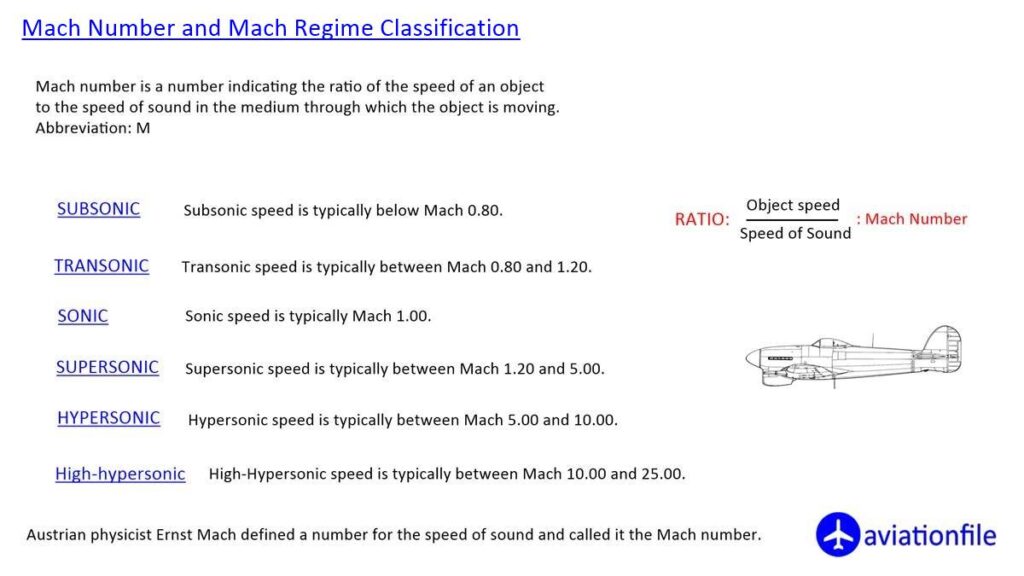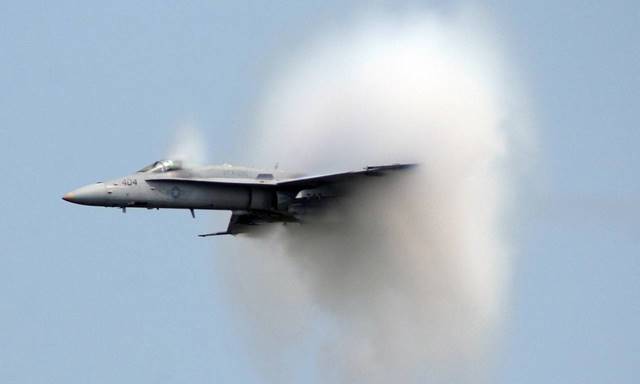What is Mach Number?
Let’s get to know the mach number, which is a term frequently used in aviation, a little more closely.
Mach number (M) is the ratio of the velocity (V) of a moving mass to the local speed of sound (a) under the conditions of the mass. Its abbreviation is Ma or M. It is named after the Austrian physicist and philosopher Ernst Mach. It is also called the Sarrau number because the French physicist Sarrau also made studies on this subject before Ernst Mach.
The local speed of sound, on the other hand, is equal to the transmission speed of the decay formed at a constant entropy in a fluid. For calorically perfect gases in air, it is assumed that the specific heat capacity does not change with temperature, so the specific heat ratio (γ) used in aerodynamic calculations is considered constant. For this reason, the speed of sound in such fluids only changes depending on the temperature. Therefore, since the local sound speed of an airplane flying at the same speed at different altitudes changes with the temperature, the Mach number will also change.
Mach Number and Compressibility Concept
Before talking about the usage areas and importance of Mach, let’s examine the concept of compressibility. All substances are actually more or less compressible because their density changes somewhat when pressure is applied or compressed on them. While this change is more in gases and less in liquids, it is inconspicuous in solids. Physically compressibility is the ratio of the change in the specific volume of a fluid element at unit pressure to its specific volume and is expressed as in the given formula:

So what is the condition for a stream to be compressible or not? First of all, let’s define the stopping point. The imaginary point at which the flow is stopped isentropically is the stagnation point, and the flow properties at this point are called the stagnation point or sum (T0, P0, ρ0, etc.). The ratio of the density of a fluid with a constant specific heat ratio to its total density depends only on the Mach number. For the region where this variation is less than 5 percent, the flow is considered reasonably incompressible. This region represents the part where the Mach number is less than 0.3.
As expected, considering the density variation in the aerodynamic calculations of flows with a Mach less than 0.3, which is the flight regime of small piston engine private airplanes, changes the results to a negligible extent. For flows with a Mach number greater than 0.3, the density variation is always taken into account, so the flows are called compressible.

Importance of Mach Number
First of all, the Mach number gives information about the regime of the flow. If the Mach number is less than one, it is called subsonic, if it is equal to one, it is called fast (sonic), and if it is greater than one, it is called supersonic. It also specifies whether the flow is compressible or incompressible as we mentioned earlier. If M<0.3, the flow is considered incompressible and the density is taken as constant in aerodynamic calculations. On the other hand, when M > 0.3, the flow is said to be compressible.
In the aerodynamic calculations for the compressible and isentropic flow of a calorically perfect fluid, other flow properties can be easily calculated if one of the properties of the flow and the Mach number are known, thanks to the isentropic equations. For example, as shown in the formula below, if the temperature of the fluid at one point and the Mach number are known, the total temperature can be calculated as well as its properties at different points in the flow. These calculations are used in many areas such as the analysis of isentropic regions of the internal flow of a jet engine, especially shock waves.
What Does Mach > 1 Mean?
If the Mach number at each point of a flow is less than 1, we can say that it is subsonic and these flows are represented by smooth (with no discontinuity in their slope) flow lines. For an external flow, a Mach number less than 1 may not be sufficient for it to be subsonic. Because the velocity of the flow over an object changes and this velocity may exceed the local speed of sound during flow. For this reason, the expression subsonic is mostly used for flows with a Mach number less than 0.8.
When the Mach approaches 1, some points in the flow exceed the local sound velocity and shock waves begin to form in regions where the Mach number is greater than 1. Shock waves are regions that are very thin or even paper-thick, and the properties of the flow change in these regions. Shock waves that occur perpendicular to the flow are called normal shock waves, while if there is an angle other than 90 degrees between the shock wave and the flow, shock waves are called oblique shock waves.
for more articles.



